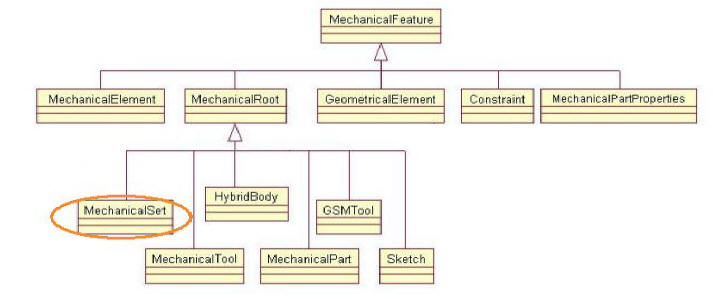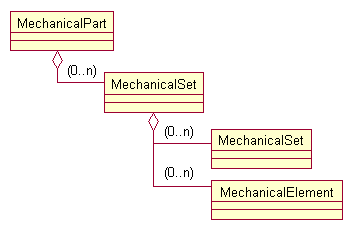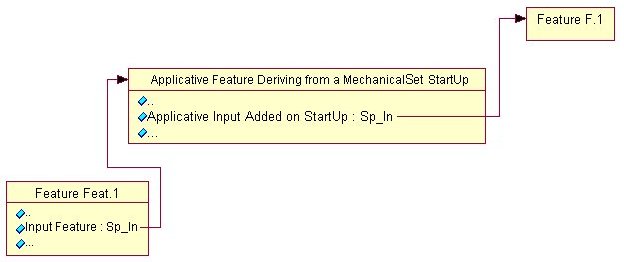 |
|
“MechanicalSet” is a StartUp derivate from MechanicalRoot |
AbstractA new Sort of Set, specially designed to aggregate Non Geometrical Features (i.e. MechanicalElement instances [1]) was born: The MechanicalSet. In this article, we are going to define it's field of application and it's default behaviors.
Note: Before going further in this article, it might be interesting to have a look at the article dealing with MechanicalElement [1] |
In internal view, MechanicalSet
derives from MechanicalRoot, just like other already-defined sets (HybridBody,
GSMTool etc…).
 |
|
“MechanicalSet” is a StartUp derivate from MechanicalRoot |
In user view, this set is defined to
ONLY aggregate MechanicalSet,
MechanicalElement and their derivatives.
Please, note this aggregation is done without any order !
 |
|
MechanicalSet's aggregation rules |
Consequently, MechanicalSet can be defined as a non ordered set designed to only aggregate MechanicalSets an MechanicalElements.
[Top]
MechanicalSet is a “base StartUp” defined to
aggregate, without any order, MechanicalElements or MechanicalSets.
It cannot be instantiated directly: it is only a derivable StartUp.
Consequently, to use a kind of MechanicalSet, you will have to create a new
StartUp, derived from MechanicalSet, in your feature catalog, just like
you do when you want to create a StartUp deriving from a Mechanical Feature [2].
For example, let’s create a StartUp “CAAMechaSet”, derived from
MechanicalSet, in the catalog “CAAMechanicalUseCase.CATfct”:
document `CAAMechanicalUseCase.CATfct`{
container CATFeatCont {
catalog_manager `MechMod.feat`
Feature CAAMechaSet MechanicalSet@`MechMod.feat’ #startup {
}
}
} |
[Top]
MechanicalSet can be used, for instance, to design an "Analysis
Set", or a "Measure Set" which aggregates analysis features designed
with MechanicalElement StartUp.
[Top]
In this section, we are going to list all behaviors supported initially by MechanicalSet 's derivates.
A “MechanicalSet” can ONLY be aggregated under the MechanicalPart
or under MechanicalSet instances.
It cannot be instantiated directly: to use it, you must create a
derivate StartUp (For instance, "CAAMechaSet" defined in "CAAMechanicalUseCase.CATfct").
Aggregation Rules:
MechanicalSet is a specific set
designed to aggregate, without any order, non geometrical
features, derived from “MechanicalElement” or “MechanicalSet”.
It can ONLY aggregate those types, or subtypes, of features.
In front of "Cut/Copy/Paste", MechanicalSet (and its derivates) has the
same default behavior as GSMTool.
This means that, cutting a MechanicalSet, all aggregated features are cut.
Moreover, pasting a MechanicalSet, all aggregated structure is pasted.
MechanicalSet supports reorder, according to aggregation rules…
This means that MechanicalSet can be reordered under the
MechanicalPart and that it can also be reordered under another MechanicalSet.
|
|
| Default MechanicalSet 's Contextual Sub Menu |
As other Sets, MechanicalSet 's Update Status depends on aggregated features ones. This means that its update Status depends on its aggregated features (i.e Features aggregated with CATIDescendants::Append()).
As we provided a global standard Update Mechanism, please, do not re-implement "CATIOsmUpdate" Interface.
Let's take the example described in the table below:
 |
| Structure Example for Parent / Children |
In this example, Feature F.1 will be seen as a Parent of the
applicative Feature deriving from MechanicalSet StartUp.
Moreover, Feature Feat.1 will be seen as one of its children.
[Top]
A BackUp/StartUp (“FeatureBackUpMechaSet”) has been defined to support basic behaviours if code is not present.
In BackUpStartUp mode, MechanicalSet instances are
replaced with FeatureBackUpMechaSet instances and icons, in the spec
tree, are replaced by this one:
![]()
Most of default behaviors, defined in the last part of this documentation, works in BackUp/StartUp mode. However, some behaviors are specifically restricted in order to prevent data's corruption.
Default Behaviours restricted in BackUpStartUp Mode:
Update Mechanism / Update Error:
An Update Error is raised when you try to update a kind of MechanicalSet’s
instance without its dedicated code or catalogue.
Cut/ Copy/ Paste :
FeatureBackUpMechaSet can be cut but it cannot be pasted. It also
can be removed from the part.
In those cases, all features aggregated under “FeatureBackUpMechaSet”, will be removed or cut, just like in nominal mode.
Replace:
FeatureBackUpMechaSet allows replace mechanism. It consists in
devaluating pointing attributes.
Reorder:
FeatureBackUpMechaSet allows reorder mechanism but it raises an
Update Error.
Visualization in Spec. Tree :
FeatureBackUpMechaSet uses default implementation of CATINavigateObject
coded for MechanicalSets i.e. Features aggregated under MechanicalSet
derivate, will be shown under its node,
even if it’s in BackUpStartUp mode
Visualization 3D View:
In BackUpStartUp Mode, visualization won’t be available under “FeatureBackUpMechaSet
instance”.
Parameters in f(x):
FeatureBackUpMechaSet uses default implementation of CATINavigateObject
coded for MechanicalSets i.e. in BackUpStartUp mode, parameters aggregated
under the MechanicalSet Instance (using CATIDesndants::Append()) will be shown in f(x).
[Top]
To have a look at the use of MechanicalElement, please refer to specified article [3]
[Top]
MechanicalSet is a derivable StartUp designed to aggregate non geometrical
features (i.e. ONLY MechanicalElement or MechanicalSet' s instance)
with specific default behavior.
It aggregates non geometrical features without any order: it is a non ordered set.
[Top]
| [1] | MechanicalElement StartUp and Feature |
| [2] | Deriving Mechanical Feature |
| [3] | MechanicalElement / MechanicalSet Use Case |
| [Top] | |
| Version: 1 [Mar 2007] | Document created |
| Version: 2 [June 2007] | Document updated: Use Case added |
| [Top] | |
Copyright © 1999-2007, Dassault Systèmes. All rights reserved.